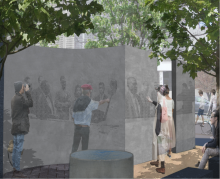Optical Illusions

Length: Two class periods.
To commemorate Nashville's role in the historic Civil Rights Movement, the Metro Arts Commission approved the selection of artist Walter Hood to create new public art. His design for Witness Walls utilizes iconic photos of the Civil Rights movement in Nashville to honor the events and the people who created the blueprint for nonviolent protest. The installation will be located on the west side of the historic Metro Nashville Courthouse, steps away from the historic April 19, 1960 student-led protest.
Through this Physics lesson, students will be able to:
- distinguish the different properties of light
- complete optical labs with appropriate steps
- use different diagrams (such as the Witness Walls) to demonstrate the path of lights with different mirrors
- identify the different meanings of domain specific language in text
- look at the Witness Walls piece and describe the different optical illusions taking place, created by the convex and concave images.
Weblink address (URL):
Originator:
eduToolbox® is a resource-sharing portal developed by the Ayers Institute for Learning & Innovation with collaborative support and funding from the Tennessee Department of Education and the U.S. Department of Education's Math & Science Partnership program.



